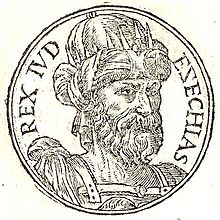Hezekiah
Appearance
| Hezekiah (Hizqiyyahu ben Ahaz) | |
|---|---|
| Keeng o Judah (Melekh Yehudah) | |
 Keeng Hezekiah frae Guillaume Rouillé's Promptuarii Iconum Insigniorum, 1553 | |
| Ring | coregency wi Ahaz 729, sole reign 716–697 BC, coregency wi Manasseh 697–687 BC |
| Predecessor | Keeng Ahaz |
| Successor | Manasseh |
| Born | c. 739 BC probably Jerusalem |
| Dee'd | c. 687 BC (aged 51 or 52) probably Jerusalem |
| Buirial | Jerusalem |
| Spouse | Hephzi-bah |
| Issue | Manasseh |
| Hoose | Hoose o David |
| Faither | Keeng Ahaz |
| Mither | Abijah (an aw called Abi) |
| Releegion | Judaism |
Hezekiah (Hebrew: חִזְקִיָּ֫הוּ, חִזְקִיָּ֫ה, יְחִזְקִיָּ֫הוּ, Modren H̱ízqiyáhu, H̱ízqiyá, Yəẖízqiyáhu, Tiberian Ḥizeqiyahû, Ḥizeqiyā, Yeḥizeqiyāhû; Akkadian: 𒄩𒍝𒆥𒀀𒌑 Ḥazaqya'u; Greek: Εζεκίας, romanised: Ezekias/Septuagint: Εζεζία, lit. 'Ezezía'; Laitin: Ezechias; an aw transleeteratit as Ḥizkiyyahu or Ḥizkiyyah) wis, accordin tae the Ebreu Bible, the son of Ahaz an the 13t king o Judah.[1]
Notes
[eedit | eedit soorce]References
[eedit | eedit soorce]- ↑ Harris, Stephen L., Understanding the Bible. Palo Alto: Mayfield. 1985. "Glossary", pp. 367–432
